![]()
Aroids and other genera in the Collection
Take the Tour Now?
Orchids
The
Exotic Rainforest
Plants in
the Exotic Rainforest Collection
Images on this website are copyright protected. Contact
us before any reuse.
In depth information on how to grow Philodendron species, Click this Link
Within our collection we have many species of Philodendron. If you are seeking other photos, click this link
Philodendron
squamiferum Poepp.& Endl.
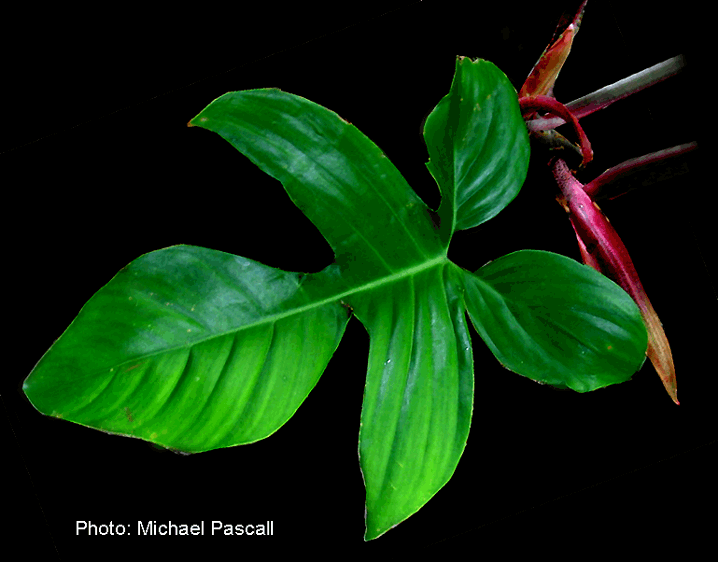
Philodendron squamiferum
Poepp.& Endl.
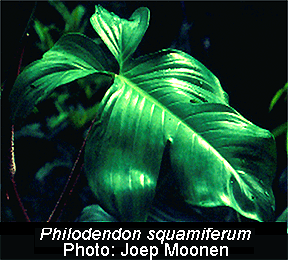 Known to exist in the rain
forests of French Guiana, Suriname, Brazil, Ecuador, Colombia, Venezuela,
and Peru, Philodendron squamiferum (squam-IF-er-um) was
described to science in 1845. An unusual multi-lobed
Philodendron, often with 5 distinct lobes, Philodendron
squamiferum can
develop even
more (or less) lobes as it matures to a fully adult
specimen. A variable species, once
past the juvenile state with an elongated
blade, the lobes are
at first a part of a single leaf blade but as the leaf gains size
to approximately 30 to 45cm (12 to 18 inches) the lobes become
more distinctive. The adaxial (upper) blade surface is a glossy
green while the lower surface is a semi-glossy gray-green. The species' lobes
often become exaggerated and quite uniform in shape but may also
"fatten" so as to become less distinctive as can be seen in naturalist Joep Moonen's (pronounced yupe) photograph.
And to add to the interest, the petioles (commonly known as
stems) of the Philodendron are a bright red covered
with long bristly scales that are often referred to as "hairs".
To a botanist those "hairs" are known as pubescence.
This red pubescence is somewhat similar to that seen on
Philodendron
verrucosum and a newly
described species, Philodendron nangaritense. Both
of those species are described on this website.
Philodendron species,
and especially hybrid forms, are
known to be highly variable and not every leaf of every specimen
will always appear the same. This link explains in greater
detail the scientific principle of natural variation and
morphogenesis.
Click
here.
Known to exist in the rain
forests of French Guiana, Suriname, Brazil, Ecuador, Colombia, Venezuela,
and Peru, Philodendron squamiferum (squam-IF-er-um) was
described to science in 1845. An unusual multi-lobed
Philodendron, often with 5 distinct lobes, Philodendron
squamiferum can
develop even
more (or less) lobes as it matures to a fully adult
specimen. A variable species, once
past the juvenile state with an elongated
blade, the lobes are
at first a part of a single leaf blade but as the leaf gains size
to approximately 30 to 45cm (12 to 18 inches) the lobes become
more distinctive. The adaxial (upper) blade surface is a glossy
green while the lower surface is a semi-glossy gray-green. The species' lobes
often become exaggerated and quite uniform in shape but may also
"fatten" so as to become less distinctive as can be seen in naturalist Joep Moonen's (pronounced yupe) photograph.
And to add to the interest, the petioles (commonly known as
stems) of the Philodendron are a bright red covered
with long bristly scales that are often referred to as "hairs".
To a botanist those "hairs" are known as pubescence.
This red pubescence is somewhat similar to that seen on
Philodendron
verrucosum and a newly
described species, Philodendron nangaritense. Both
of those species are described on this website.
Philodendron species,
and especially hybrid forms, are
known to be highly variable and not every leaf of every specimen
will always appear the same. This link explains in greater
detail the scientific principle of natural variation and
morphogenesis.
Click
here.
Philodendron
squamiferum is known to be an epiphytic vine and
grows well up into the jungle trees. The
 species was popular as a house plant in the 1950's but
after the 1960's lost its popularity and was not
commonly available in cultivation until 2005 when it was
reintroduced as a tissue culture (cloned) plant.
species was popular as a house plant in the 1950's but
after the 1960's lost its popularity and was not
commonly available in cultivation until 2005 when it was
reintroduced as a tissue culture (cloned) plant.
Dutch naturalist Joep Moonen, who resides and works in the rain forest of French Guiana, made these observations regarding Philodendron squamiferum , "This species is one of the prettier Philodendron of the Guianas. In Suriname it is rare, here in French Guiana it is not common but less rare then in Suriname. We have them growing here along our Botanic Trail both naturally as well as 'planted' on tree trunks. We have them in flower a few times a year. The species likes to grow in the shade with some sunlight, perhaps an hour filtered sun per day. The most amazing feature, the 'hairs'. are red in many plants and green in some. I have never seen a connection between the light level and the color of the 'hairs'. The adult leaves are about 25 cm, so you can call it a medium size species. The leaves remain smaller than Philodendron pedatum. " In a separate email, Joep noted from personal observation, "P. squamiferum also grows in Guyana (formerly British) and AmapÓ State in northern Brazil."
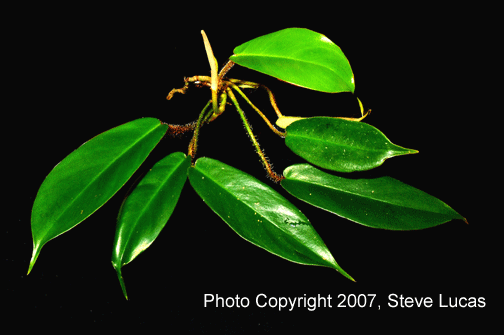
Philodendron squamiferum, like all Philodendron species, morphs as it grows. The juvenile plants look nothing like the sub adult plants which look little like the adult forms. The ontogeny of aroid species (morphogenesis) is common and in addition all aroid species are variable. Simply, not every leaf of every specimen of the same species will look alike. For an explanation of morphogenesis and natural variation within aroid and other plant species, click this link.
The spathe of P. squamiferum is burgundy with white on the upper
portion. The interior of the spathe is white. In the
rain forest, it is not uncommon for nature to have
"assigned" the task of pollination to species such as
Philodendron squamiferum to a single species of
insect. In French Guiana botanists have
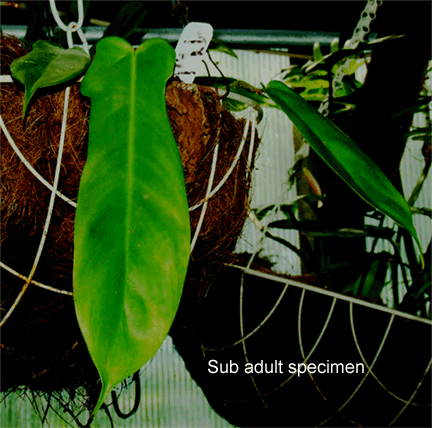 observed the
inflorescence of Philodendron squamiferum were
often frequented by a scarab beetle known to science as Cyclocephala
simulatrix and occasionally by Cyclocephala
tylifera. According to personal conversations with
aroid botanist Dr. Tom Croat of the Missouri Botanical
Garden in St. Louis it is not uncommon to observe a
species of scarab beetle entering the spathe and spadix
of an aroid in to pollinate the species.
Typically, the pollination cycle of these beetles last
approximately two days according to researchers. The
beetle is apparently drawn to the spadix in to
gain food available only during the period the spadix
is at anthesis (ready to be pollinated). Additionally,
the pheromone may be a trigger to cause the beetle to
find a mate and produce offspring. Apparently, in
addition to the normal pheromones produced to attract an
insect pollinator, the inflorescence of Philodendron
squamiferum also has a very slight temperature
increase when at anthesis and this temperature change
also serves to attract the beetles. This slight
warming actually appears to be the major attractant to
both the arrival and departure of the beetles.
observed the
inflorescence of Philodendron squamiferum were
often frequented by a scarab beetle known to science as Cyclocephala
simulatrix and occasionally by Cyclocephala
tylifera. According to personal conversations with
aroid botanist Dr. Tom Croat of the Missouri Botanical
Garden in St. Louis it is not uncommon to observe a
species of scarab beetle entering the spathe and spadix
of an aroid in to pollinate the species.
Typically, the pollination cycle of these beetles last
approximately two days according to researchers. The
beetle is apparently drawn to the spadix in to
gain food available only during the period the spadix
is at anthesis (ready to be pollinated). Additionally,
the pheromone may be a trigger to cause the beetle to
find a mate and produce offspring. Apparently, in
addition to the normal pheromones produced to attract an
insect pollinator, the inflorescence of Philodendron
squamiferum also has a very slight temperature
increase when at anthesis and this temperature change
also serves to attract the beetles. This slight
warming actually appears to be the major attractant to
both the arrival and departure of the beetles.
Some
growers and websites indicate Philodendron squamiferum
needs "abundant water". They also advise to keep the
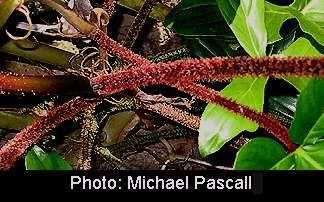 soil moist
at all times. This is a bit confusing since the company that
creates the tissue cultured form of P. squamiferum
plant says exactly the opposite on their website. They
recommend watering the plant only when the medium in which
the Philodendron is planted begins to dry.
We have chosen, after losing quite a few small plants, to grow
our Philodendron squamiferum in a very loose soil
mixture which contains a moisture control mix along with a large
quantity of orchid potting media added. We deliberately chose
to use a mix containing charcoal and hardwood bark in to
allow our specimens to duplicate their normal epiphytic habit of
attaching roots to wood. The majority of the year we water
thoroughly when the specimens just begin to show signs of
beginning to dry.
soil moist
at all times. This is a bit confusing since the company that
creates the tissue cultured form of P. squamiferum
plant says exactly the opposite on their website. They
recommend watering the plant only when the medium in which
the Philodendron is planted begins to dry.
We have chosen, after losing quite a few small plants, to grow
our Philodendron squamiferum in a very loose soil
mixture which contains a moisture control mix along with a large
quantity of orchid potting media added. We deliberately chose
to use a mix containing charcoal and hardwood bark in to
allow our specimens to duplicate their normal epiphytic habit of
attaching roots to wood. The majority of the year we water
thoroughly when the specimens just begin to show signs of
beginning to dry.
However, that may seem somewhat strange since the species is a native to very wet rain forests. Apparently the difference is P. squamiferum grows almost exclusively as an epiphyte (ep-a-FIT) and is rarely if ever found growing in soil. The Philodendron apparently needs to have its roots damp, but never in wet potting media. But it may also that be the species simply does not like excess water while young since once it is well established the amount of water appears to be less critical.
Our largest specimen was a gift from grower Steve Marak. His specimen came from the Missouri Botanical Garden as a cutting verified and collected by Dr. Tom Croat. My thanks to Joep Moonen (pronounced yupe) for his contribution and photo as well as to Australian Michael Pascall for the use of his excellent photographs.
If you actually wish to see this species, and many more, in the jungles of French Guiana, our friend Joep Moonen (pronounced yupe) introduces people to those exotic rain forests almost daily. For an Emerald Jungle Village eco-tour brochure contact Joep at EmeraldJungleVillage@wanadoo.fr
Want to learn more
about aroids?
Join the
International Aroid Society:
http://www.exoticrainforest.com/Join%20IAS.html
Looking for a specimen? Contact
http:///
![]()